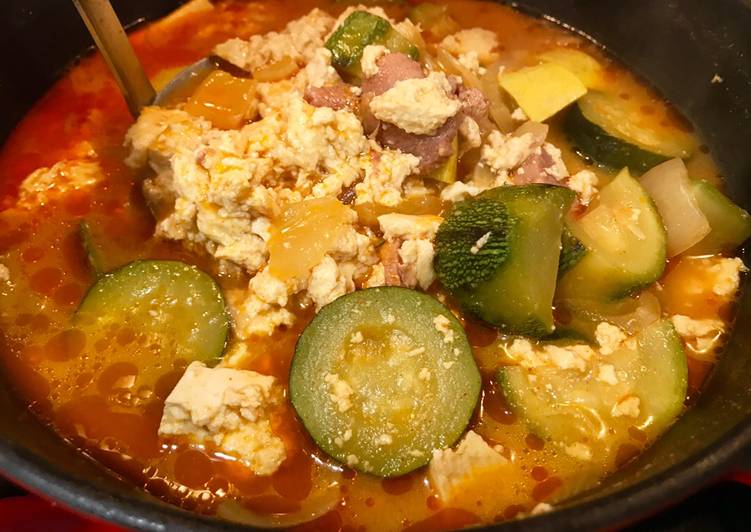Spicy Hobak Jjigae (Korean Squash Stew) with Pork & Tofu. Great recipe for Spicy Hobak Jjigae (Korean Squash Stew) with Pork & Tofu. See great recipes for Spicy Hobak Jjigae (Korean Squash Stew) with Pork & Tofu too! Jjigae (TCHEE-geh) is Korean for stew and, as in English, refers to any number of heartier (and in the case of Korean food, more pungent) dishes that are thicker than soup, which, in Korean culture is considerably more brothy than a lot of the stuff we here in US call soup.
 Gochujang Hobak Jjigae (Spicy Zucchini Stew) Gochujang Hobak Jjigae is my go-to stew that I mentioned in my recent Yache Twigim post. Because this recipe does not contain any meat(the broth is dried anchovy stock so it's not fully vegetarian but close), it is really light (there's no fat in this) but still very flavorful. You will need very fermented cabbage kimchi to make this stew. You can have Spicy Hobak Jjigae (Korean Squash Stew) with Pork & Tofu using 9 ingredients and 5 steps. Here is how you cook that.
Gochujang Hobak Jjigae (Spicy Zucchini Stew) Gochujang Hobak Jjigae is my go-to stew that I mentioned in my recent Yache Twigim post. Because this recipe does not contain any meat(the broth is dried anchovy stock so it's not fully vegetarian but close), it is really light (there's no fat in this) but still very flavorful. You will need very fermented cabbage kimchi to make this stew. You can have Spicy Hobak Jjigae (Korean Squash Stew) with Pork & Tofu using 9 ingredients and 5 steps. Here is how you cook that.
Ingredients of Spicy Hobak Jjigae (Korean Squash Stew) with Pork & Tofu
- It's 1/2 of onion, diced.
- You need 1-2 of jalapeños, cut into 1/8" thick slices.
- You need 2-4 of garlic cloves peeled and smashed (or chopped).
- It's 1/2 pound of pork shoulder, thinly sliced.
- It's 1/4 cup of dwenjang (Korean soybean paste) OR miso (which is the Japanese version).
- You need 1/4 cup of gochujang (Korean chili paste).
- It's 4 cups of water.
- Prepare 4 cups of calabacita squash or zucchini, cut into 1/2" thick slices (about 2 to 3 medium squashes).
- Prepare 1 (14 oz.) of package tofu (can be any firmness).
Doejigogi Hobak jjigae, 돼지고기 호박찌개 (Spicy Pork and Zucchini Stew) Very simple and easy to make stew with pork and zucchini. When you have abundant zucchini, this will make a. Also some red chili pepper powder, doenjang, dried anchovies and dried kelp. A simple, comforting Korean stew with spicy, tangy flavors and a whole lot of pork belly.
Spicy Hobak Jjigae (Korean Squash Stew) with Pork & Tofu step by step
- Put all ingredients except squash and tofu in a pot, cover, turn the heat to medium high, and cook for 15 minutes..
- Give the jjigae a few good stirs. You'll see the jjigae change color as the dwenjang and gochujang dissolve into the broth. Let the jjigae continue cooking uncovered for 2 to 3 minutes until it comes to a boil..
- Add squash, give it a few good stirs, and cook another 15 minutes covered..
- Crumble tofu into the jjigae. (This is not typical - usually it's cut into cubes or slices - but I like it this way because the tofu picks up more flavor from the broth.) Cover and cook another 10 minutes. Don't worry that the broth is constantly boiling rather than simmering. Jjigae gets its well developed pungency from this constant application of higher heat and the resulting compounding, melding, and reduction of flavors..
- At this point, give everything another good stir and see if you need to adjust the seasoning. If it tastes fine, you're done. If a little too salty, add a touch of water. If you want more saltiness, you can add a little more dwenjang and/or gochujang, remembering that the gochujang is much hotter (as in spicy) than the dwenjang. If you do adjust the seasoning, let it boil another 4 or 5 minutes to let the new level of seasoning meld. That's it. Enjoy!.
Kimchi Jjigae (Korean Kimchi Stew) A quick to prepare Korean spicy pork and zucchini stew, perfect for cold weather, and plenty of rice. Cold weather is the best time to enjoy a steaming pot of spicy dish, especially with how cold the weather gets in Minnesota, this is the perfect time to share the recipe for Korean spicy pork zucchini stew. It's hot, spicy, filling, comforting, delicious, soft tofu stew and has many reasons to be one of the most popular items in Korean restaurants. I made a video and recipe for sundubu-jjigae seven years ago (!) and it's been watched over a million times on YouTube (!!). Saeujeot is a staple ingredient most commonly used in kimchi but its distinct savory flavor works wonderfully as a seasoning for various other dishes such as gyeran jjim (steamed egg), sundubu jjigae (soft tofu jjigae), kongnamul guk (soybean sprout soup) and bossam (boiled pork).

No comments:
Post a Comment